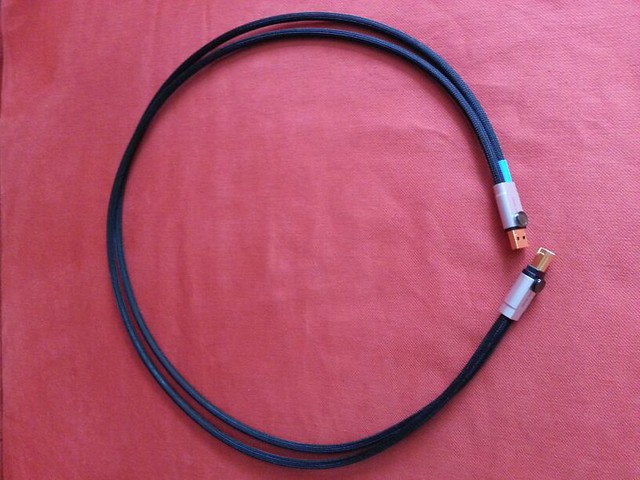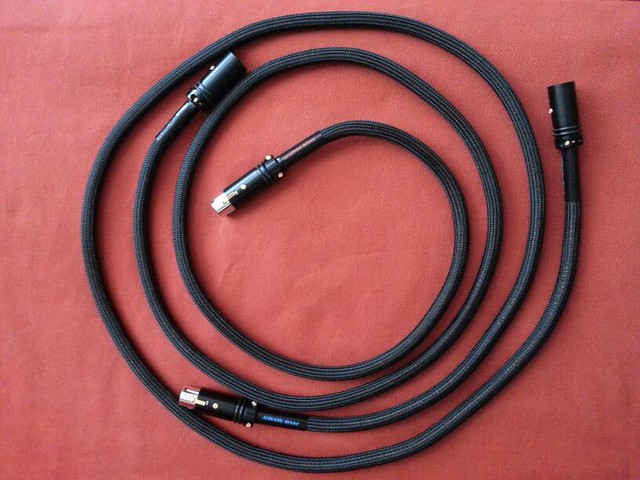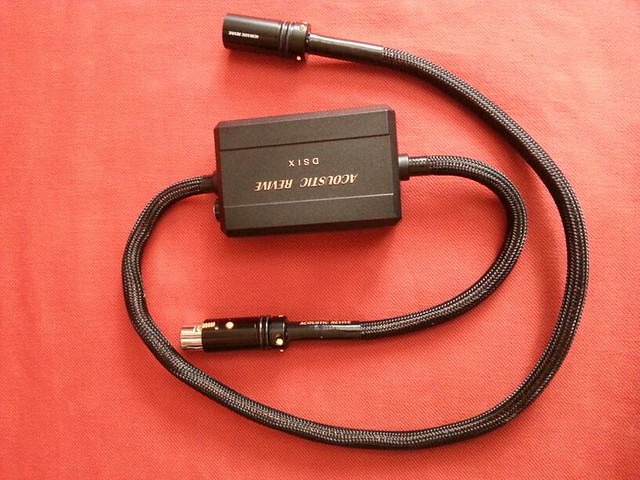In this multiple review, I am going to evaluate a number of Acoustic Revive interconnects which I purchased along with some friends after the Munich high-end festival. In the article I will evaluate three different Acoustic Revive USB cables, a pair of XLR interconnects (XLR-1.0PA II) and an AES/EBU active connector (DSIX-1.0BPA II). The USB models are the USB-1.0SP, USB-1.0SPS and USB-1.0 PLS.
The whole Acoustic Revive series have a few traits in common: they are all aimed to obtain a balance between an organic sound signature and a detailed and spacious representation, and all of them employ solid core copper conductors.
The USB cables have in common the separation of the signal and power line, through separated branches. They differ like follows: the USB-1.0SP and USB-1.0SPS are twin cables with two separate male USB plugs to the PC, and two different branches going to a single male connector to the DAC. The USB-1.0PLS uses a single male USB plug to the PC, but, from there, two distinct branches start from it and run in isolation to the DAC. Thus, the signal line and the power line are totally separated with the SP and SPS models (until rejoining to the DAC end), whereas the signal and power line have one more point in common with the PLS model, at the beginning. The SPS is the direct upgrade to the SP model, and employs a different dielectric. The PLS employs the same dielectric as the SPS.
The XLR-1.0PA II model uses a newly evolved copper conductor based on an oval section, and is an evolution of the former models that’s just launching on the market.
The DSIX-1.0BPA II (which is called “balanced digital isolation exciter” on Acoustic Revive website), is an AES EBU cable that uses an isolation transformer in the middle (probably a battery), combined with an external charger to put an electrical bias on the cable. Balanced type cables with bias are often (in fact, usually) used in recording and sound studios, and often in performance venues. This approach has the effect of strongly rejecting jitter.

Test System
The three USB cables have been employed with two different systems:
April Eximus DP-1 / Yulong D200 -> Silver.Fi Samarkand -> Stax SRM-007t -> Stax Lambda Nova Signature earspeakers
April Eximus DP-1 / AMR DP-777 -> Kimber Hero -> Electrocompaniet ECI3 -> Neotech Speaker cables -> Mordaunt Short Performance 6 speakers
The Eximus and AMR have been used out of Windows Server 2012 computer, a Windows 7 computer, a 2010 iMac 27? and a Marantz PMD325 CD player.
The USB cables have been tried extensively against a JCAT, a collection of Lindy cables, Belkin Gold and Audioquest cables.
The XLR cables have been compared to my SilverFi Samarkand and a set of Kimber Hero.
For the DSIX AES-EBU cable, I used ? and ? transports with the Eximus and AMR, and a ? standard AES-EBU cable as a mean of comparison.

Sound
When listening to music with the three USB cables, I gathered two major impressions: the three cables share the same tonal balance, only differing slightly in levels of refinement.
The second one is that the three Acoustic Revive cables are much more easily recognizable when used with the AMR DP-777 than with the Eximus DP-1 or Yulong D200. Such a behaviour is more a trait of each USB receiver, and, as usual, can be understood as the capability of the receiver to scale with a better input, as well as its inherent jitter rejection qualities.
The Acoustic Revive USB series is euphonic, warm, energic sounding and natural. They are tuneful, with a “layer” of warmth. When used with Eximus, the sound reminds that of a better refined Lindy ‘black/red’ cable or than a Belkin Gold cable, with a less mellow balance, a bigger soundstage and slightly better transparency. When used with the AMR, the difference with lower end cables is much bigger, with much more information, transparency, low level details, and the same tonal balance.
In both cases, the upper bass presence helps music to reach the listener, in a similar way as the JCAT does, but with a darker overall tonality.
The JCAT offers a different presentation, with more upper midrange, and makes the AMR even more sensitive to detail retrieval. The AMR also gains some nerve when used with the JCAT cable, and music gains a stronger live and toe-tapping quality, whereas the Acoustic Revive cables make the listening feel comparatively closer to a Jazz club filled with cigar smoke, while tasting a superalcoholic.
The Yulong D200 is the least sensitive to USB cables swaps: as always, SABRE based DAC’s approach the digital signal processing in their own unique way, and tend to be the less sensitive to the upstream components.

The XLR cables follow the same phylosophy, and they are very warm sounding, with a bit less open top end than the Samarkand. They are slightly thicker than the Kimber Hero, and pretty much equally detailed, resulting in a richer contribution to the music.
They offer have a wdie sense of space their upper bass richness, and a relaxed, but dense overall presentation. They don’t have the same special deep bass and attack that’s offered by the Samarkand, but approach the sound differently.
The DSIX has a main effect on the systems it’s placed in: it’s a combination of a warm sounding conductor (solid core copper) and an isolator designed for high jitter rejection. I have compared it to a Silversonic AES-EBU cable on a Marantz PMD325, and the DSIX offers a stronger tonal saturation and soundstage depth.
Compared to the signature sound of all the other AR cables, the DSIX has a slightly stronger accent to treble, with resulting in a more live presentation, a combination of a slightly aggressive pitch and saturated tonality. Such a treble accent (consequence of the strong jitter rejection) never “rip” the courtain of a warm presentation: in other words, treble never gets sharp nor sibilant. The usage of the DSIX effectively translates in strengthening the sense of being immersed in realistic a 3D space.

Conclusion
The value of the Acoustic Revive products I have been describing can vary from a “safe bet” to a great purchase, depending on the DAC and systems they are used in. They will never screw up the sound, and will always play within the “tonal rightness” boundaries. For the cost (which varies depending on the country distributors), the USB cables are a great purchase with DAC’s like the AMR DP-777, and more in general with very transparent DAC’s with a USB input capable of scaling. I have also tried the USB cables with the JKenny Ciunas USB to SPDIF converter (and SilverFi D3 coaxial cable), and in this case, there were probably so many additional variables to estinguish any significant difference between any USB cable. Other USB to SPDIF converters, such as the Audiophilleo, used to be more sensitive to USB cables swap.
As said, in my tests I felt the three USB models shared similar sound signature; in a sense, this is encouraging since it grants consistency among a brand’s signature across time, and prevents from headaches when searching for a specific product that could have gone out of production.
From a practical point of view, the PLS only needs a single USB port whereas the SPS and SP need two. The first approach is more compact (and the PLS is a less expensive device). Anyway, with certain DAC’s, which don’t need the power line at all, the SPS and SP offer the possibility to completely disconnect the power branch from the PC, thus only having to deal with the signal.
The DSIX is probably one of the most fascinating piece of gear I have played with: it’s such a quirky concept to tilt some fetishist chords, and offers a cost/no-object digital connection that’s ideal for a high end system that’s fully balanced, and possibly fully grounded to get the best out of it.


